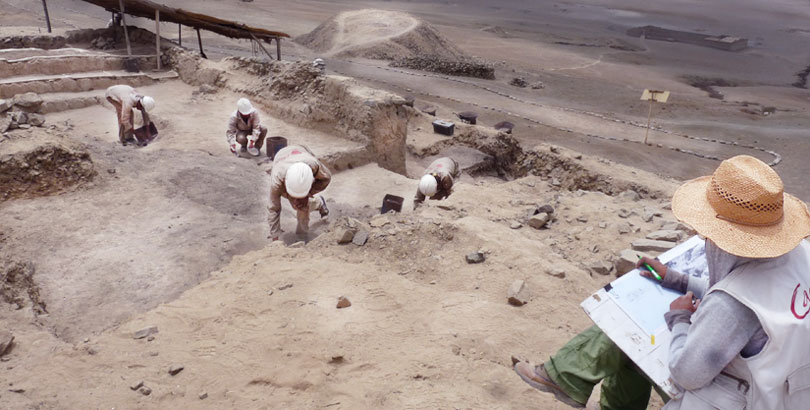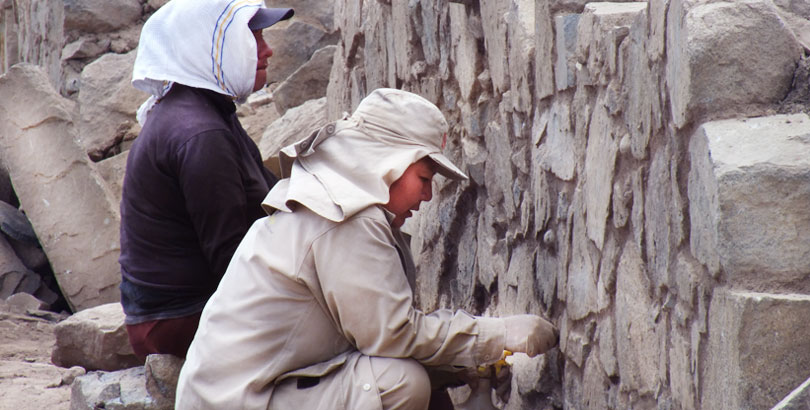Preservation of Monuments

The Monument Preservation Process
In its research policy, Caral Archaeological Zone regards the preservation of the investigated sites as a fundamental aspect that must not be neglected. To do this, theoretical and methodological guidelines are taken into account, governed by international documents on the preservation of built heritage.
Caral Archaeological Zone, with the participation of a multidisciplinary team of conservation specialists, has embraced the principles of conservation basically inspired by the Venice Charter (1964-65), supplemented by the experience of the last decades of the 20th century in subsequent charters adopted by ICOMOS, including the Burra Charter’s conservation and management guidelines (in its three updates, of 1979-81-88 and 99), and those of the Zimbabwe Charter (2003), applied to the situation of the conditions of the ancient city and its environment.
Context
Seismic destruction of the archaeological heritage is considerably greater in buildings made of earth or stone and mud than those made of any other material. Three main facts enable us to define the problem of the greater occurrence of damage in monumental earthen constructions located in seismic areas, and the challenge of successfully conducting the complex task of intervention to prevent the irreversible loss of monumental value of the Sacred City of Caral.
- The unique nature of constructions of stone with mud mortar and, in a short period, of adobe with mud mortar, due to their weakness, fragility, and vulnerability. Adobe or stone masonry with mud mortar resists about ten times less than burned brick masonry.
- El carácter único de las construcciones de piedra asentada con barro, y en un corto período de adobes asentados con barro, por su debilidad, fragilidad y vuTThe great coincidence, in different parts of the world, between the location of monumental earthen works and seismic activity, as in the case of the City of Caral and most of Peru’s immense cultural heritage. The forces of inertia, or seismic forces, produce stresses on the structures that are far greater than can be borne by those structures designed only for forces of gravity. Such forces cause cracks and failures in the structural elements that can lead to partial or total collapse.
- The failure of the International Conservation Charters (adopted by ICOMOS) to make a distinction between the conservation treatment for heritage buildings in seismic and non-seismic areas, especially in the particular case of earthen or stone constructions with mud mortar. The rate of damage to the heritage in seismic areas is very different to that produced in areas without seismic activity. Seismic recurrence creates an accumulation of structural damage to levels of collapse and disappearance of the heritage value.

Restoration and Conservation
One day in the future, the most important conservation work done by ZAC will be merely preventive and based on the maintenance of a respected heritage, which will irradiate historical knowledge and education to the region and the world. At present, however, it is necessary to carry out restoration and conservation activities on the archaeological monuments being researched.
Restoration is a multidisciplinary scientific and technical operational process, which, following a critical-analytical methodology, seeks to recover and transmit historical and aesthetic values under strict respect for the authentic evidence. Restoration ends where hypothesis begins. The calling to restore rather than reconstruct is always emphasized.
However, we bear in mind an important ruling of the Venice Charter: “… it is essential that the principles guiding the preservation and restoration of monuments be consensual and formulated in an international dimension, with each nation being responsible for applying a planning within the framework of its own culture and traditions,” to which we would add “and the geomorphological, environmental, and seismic conditions of its territory.”
The main principles and specific criteria applied to restoration activities are the following:
- Restoration ends where hypothesis begins. In this reference, completion work is not done to the archaeological monument unless the data from the archaeological research are sufficiently clear. Completion by analogy, typology, or stylistic considerations are not regarded as valid, let alone completions pandering to tourism.
- Restoration is always preceded and accompanied by an archaeological and historical study of the monument, of the condition it was in when excavated, and of the conditions of the natural environment where it is located.
- Work on a monument takes into account respect for its architectural components, its materials, construction typology, results of analyses, and relationships with the environment.
- Indispensable additions are as closely adapted as possible to the context. A discreet difference is made between new and old elements.
- Because of the nature of the materials and the different construction systems employed in the monuments over time, the restoration principles are applied according to the indicated criteria, and case by case, with the advice of the investigating archaeologist.
- The reintegration or replacement of dispersed elements is done only when their original locations are known for certain, and in those cases where it is necessary to restore the structural stability of the monumental group or its components.
- Restitution work shall be limited to proven cases where it is indispensable to guarantee partial or full seismic stability; and always taking into account the known past condition. Preferably, only resort to the recomposing of existing dismembered parts if this is inevitable, permanent reinforcement is minimal, and it is reversible. In this kind of intervention, seismic recurrence is taken into account, as well as the known cumulative effect of structural damage.
- The elements of integration should always be recognized and they are the necessary minimum intervention to ensure the monument’s preservation and restore the continuity of its forms.
With regard to conservation (or maintenance), it is clear that the conservation work does not end with the first intervention: rather, this is where it begins. To preserve the architectural building, an ongoing maintenance plan needs to be implemented, and for that purpose the monitoring of all the structures that make up the building is indispensable.
Maintenance involves cleaning, protecting floors or pavements, desalination, and repair work.
Physical protection includes activities for security against theft or vandalism or any other negative action produced by human beings; environmental attacks such as wind, drizzle or rain, sand, humidity, and radiation; and deterioration due to the presence of animals. Some types of protection are: covers, windbreaks (of stone, or organic or synthetic material), and the planting of screens of trees.
Together with the careful observation of the above principles and guidelines, in the Sacred City of Caral, World Heritage, the following conservation methods and techniques have been applied:
- Preliminary photogrammetric analysis and monitoring.
- Preservation of quincha (wattle-and-daub) structures.
- Comprehensive maintenance of quincha components and surfaces.
- Preservation of quincha walls.
- Patching of cracks and losses of mortar and plaster.
- Treatment of floors.
- Reliable replacement of stone blocks in walls and platforms.
- Preservation of external and internal plastering.
- Preservation of plastering and sculptures on flat mud surfaces.

